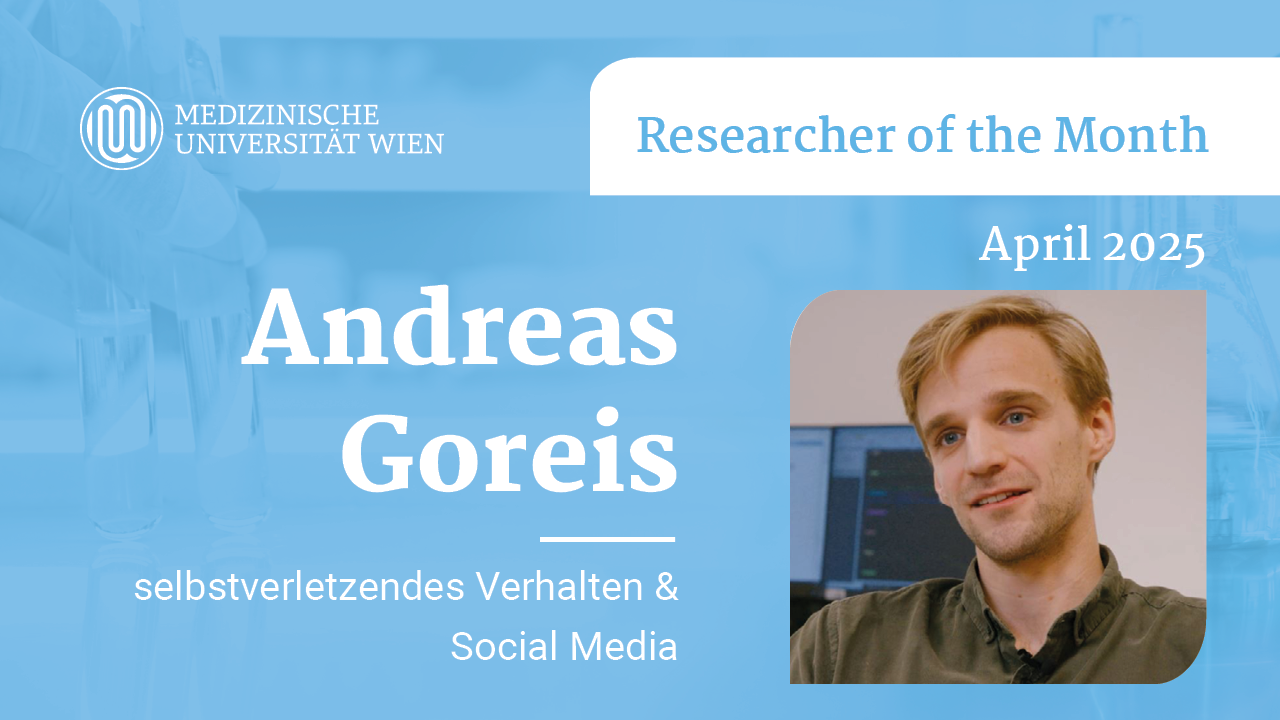
After activation, data will be sent to YouTube. Further information here: Data protection
English subtitles on Youtube available: click on the gear icon and select “Untertitel” – “English”
Dr. Andreas Goreis

MedUni Wien RESEARCHER OF THE MONTH April 2025
Nonsuicidal self-injury (NSSI) is a significant clinical concern among adolescents. Exposure to NSSI-related content on social media platforms has been hypothesized to act as a potential trigger for NSSI. In this study, we used a free-viewing eye-tracking paradigm and a dot-probe task to examine attentional biases and psychophysiological responses to NSSI-related pictorial stimuli in adolescents with and without a history of NSSI.
Adolescents with a history of NSSI—but not those without—exhibited a clear attentional bias toward NSSI-related images during eye-tracking, indicated by increased initial fixations and longer fixation durations. This bias was associated with a heightened urge to engage in NSSI, a pattern not observed in the control group. Similarly, in the dot-probe task, only the NSSI group demonstrated an attentional bias toward NSSI images, but not toward trauma-related images, underscoring the specificity of the bias.
Our findings reveal a specific attentional bias toward NSSI-related pictorial stimuli in adolescents with a history of NSSI, particularly reflecting difficulty disengaging from such images. These results contribute to our understanding of maladaptive information processing in NSSI and suggest implications for clinical management and cognitive models addressing NSSI-related triggers.
Selected Literature
- Goreis A, Pfeffer B, Hajek Gross C, et al. Attentional Biases and Nonsuicidal Self-Injury Urges in Adolescents. JAMA Netw Open. 2024;7(7):e2422892. doi:10.1001/jamanetworkopen.2024.22892
- Castellví P, Lucas-Romero E, Miranda-Mendizábal A, et al. Longitudinal association between self-injurious thoughts and behaviors and suicidal behavior in adolescents and young adults: A systematic review with meta-analysis. Journal of Affective Disorders. 2017;215:37-48. doi:10.1016/j.jad.2017.03.035
- Farkas BF, Takacs ZK, Kollárovics N, Balázs J. The prevalence of self-injury in adolescence: a systematic review and meta-analysis. Eur Child Adolesc Psychiatry. Published online July 24, 2023. doi:10.1007/s00787-023-02264-y
- Swannell SV, Martin GE, Page A, Hasking P, St John NJ. Prevalence of Nonsuicidal Self-Injury in Nonclinical Samples: Systematic Review, Meta-Analysis and Meta-Regression. Suicide and Life-Threatening Behavior. 2014;44(3):273-303. doi:10.1111/sltb.12070
- Lloyd-Richardson EE, Perrine N, Dierker L, Kelley ML. Characteristics and functions of non-suicidal self-injury in a community sample of adolescents. Psychol Med. 2007;37(8):1183-1192. doi:10.1017/S003329170700027X
- Goreis A, Prillinger K, Bedus C, et al. Physiological stress reactivity and self-harm: A meta-analysis. Psychoneuroendocrinology. 2023;158:106406. doi:10.1016/j.psyneuen.2023.106406
- Dyson MP, Hartling L, Shulhan J, et al. A Systematic Review of Social Media Use to Discuss and View Deliberate Self-Harm Acts. Seedat S, ed. PLoS ONE. 2016;11(5):e0155813. doi:10.1371/journal.pone.0155813